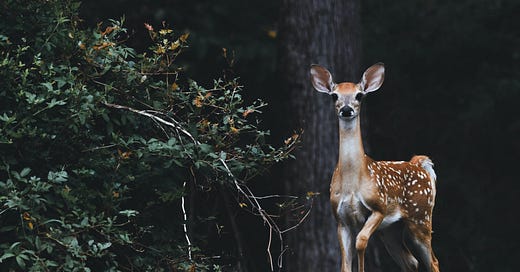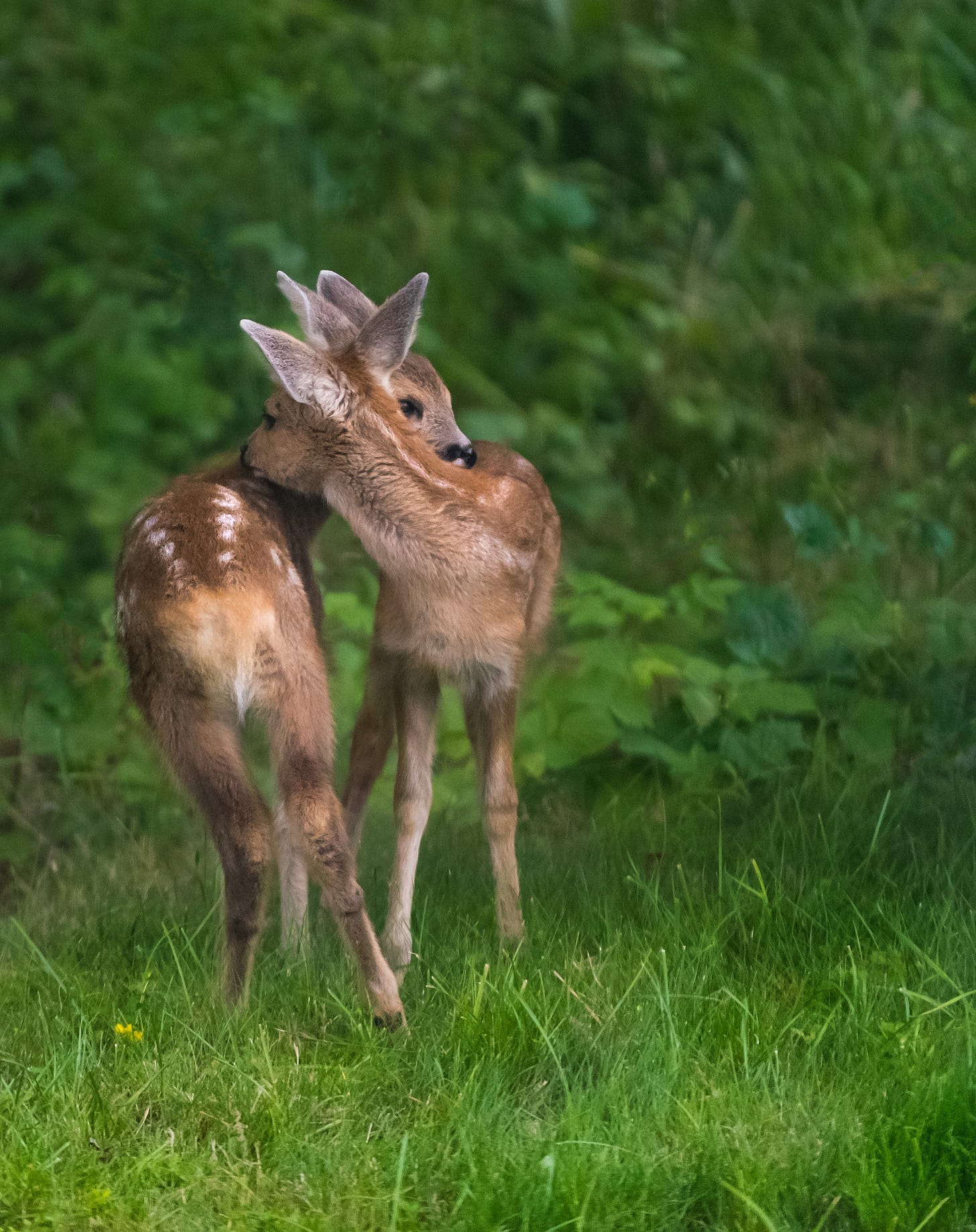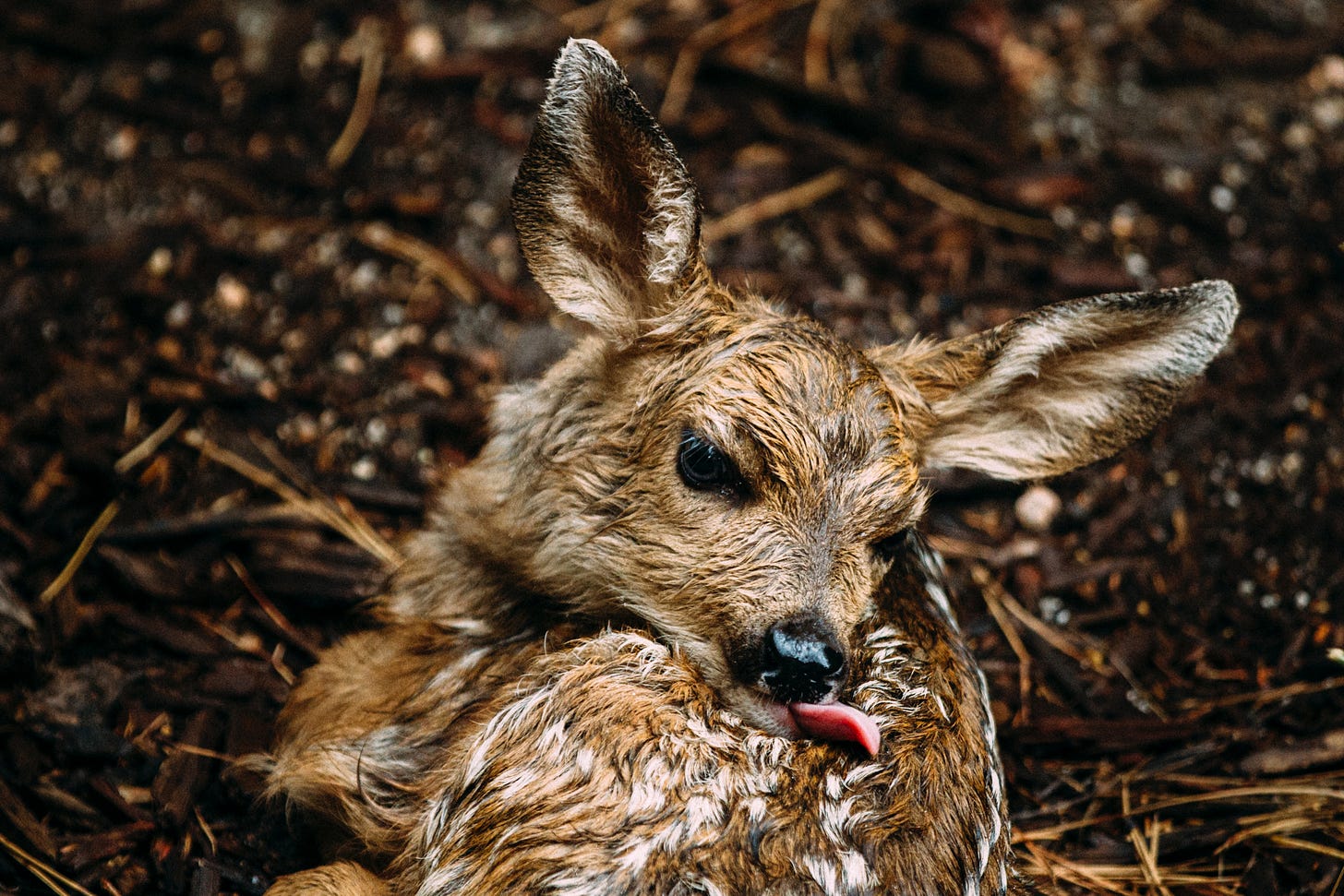Shoes crunched dry dirt and dead fallen leaves as I walked through the forest at first light, heading for the garden. My head whipped to the right when I heard something crash through a deep stand of pines. A flash of light brown, then black, then gray fur shot by like arrows let loose through the trees. A few seconds later, an adult deer ran full speed down the path, brushing past me like I was a ghost. For a heartbeat or two, I thought she was running at me and might mow me down, but she flew by close enough to touch and rocketed toward the brambles by the pond. She was trying to draw them off.
* * *
Exertion/Capture Myopathy is when high stress causes damage to muscle tissue, including the heart, often resulting in renal failure. The animal’s body burns up all reserve calories and oxygen, over-straining the muscles and heart. Once this level of stress triggers in the body, it is almost always fatal.
* * *
The babies came late this year. Twins on shaky legs stood at their mama’s flanks, learning how to nurse. White spots dappled their soft brown coats. Big brown saucer eyes scanned the forest in awe of the towering, one-legged, green-needled giants standing around. Mama Doe was born here a couple of years ago, had one baby last year, and came again this year to birth the twins.
Our land is a sixteen-acre rectangle with no outer fence lines, which is very rare in this valley. Most properties around here erected tall privacy fences years ago to comply with new state regulations for growing and hiding any visual sight of legal marijuana. Tall Doug Fir, Ponderosa Pine, Madrone, and Oak trees inhabit the upper bench of our land. An overgrown pond full of mud and cattails, a garden, and a small unruly meadow full of wild rose and untamed grasses cover the lowland. Having no fence line means wild animals can access this land and use the habitat freely. It’s the reason we chose not to have dogs on this land. We wanted to keep as much of the wild habitat intact as possible and help keep a wild animal corridor open.
Bobcats, fox, skunks, raccoons, opossums, and an occasional cougar and bear frequent this corridor. Mama Doe is smart. She knows the larger carnivores prefer to skirt around the houses and human yards, making those zones safe for the fawns. When drought descended here like an anvil in July, she taught the twins to lay in the shade of the cedar tree next to a water bucket my mom leaves out during the bone-dry months. When the twins are bedded down calmly in the yard, Mama Doe leaves them there and goes to the open meadow to forage for any living semi-green grass or leaf she can find. The meadow is a risky move. It borders the irresponsible neighbors property who let their dogs run roughshod through this rural residential neighborhood.
* * *
I took off scrambling in the direction the deer bolted from, knowing it was the irresponsible neighbors’ dogs running the fawns down for the third time this week. My gangly human legs smashed through the parched forest floor catching the attention of the large black dog who looked my way just as the tiny, dappled fawn suddenly collapsed in the willow bushes behind the shed.
Screaming like a mad banshee, I chased the dogs all the way to the southeast property line, where I found one of the irresponsible neighbors and let fly some daggered words. The young man with blond dreds and dusty black trousers had the audacity to ask me if they could have the fawn’s carcass and salvage the meat. I get it. Waste not, want not. But what on this good green earth makes him think I would reward them with venison veal for allowing their dogs to run rampant in the neighborhood? I walked away disgusted with these people, wishing they were more like the respectful, awesome neighbors with huskies on our eastern boundary.
One of the travesties in life is not being able to choose who moves in next door.
Trotting back up the path, I wished for the little deer to still be alive. From my vantage point, it was impossible to see if it collapsed from the one of the three dogs taking it down, from pure exhaustion, or if it found an escape hatch in the willows. Within twenty feet of where I saw the baby fall, I slowed my pace and stood there quietly. If it was alive and injured, maybe I could do something for it. Nothing moved. Not a leaf or twig shuddered in those bushes. I carefully approached a spot where dead grass indented nest-like beneath some over-arching willow branches. The baby wasn’t there.
That evening the Thursday sun took on a reddish hue as the air tide shifted, bringing in smoke from the north. Mama Doe stood in the trees near the willows snorting hard and fast multiple times in some sort of call to the missing twins. She was agitated, walking back and forth across the land with her nose to the ground like a hound dog sniffing for her babies. Distressed and distraught, she shot a look at me across the yard as clear as words, “Where are they? Where are my babies!!??”
I wanted to cry and hug her and tell her they are around here somewhere.
Keep looking, Mama Doe.
I fell asleep that night with an ache in my heart.
* * *
The next day I walked over to mom and dad’s house on the western side of the land to watch a Friday movie and eat some Whirly Pop popcorn. The mercury was hovering just below 100 degrees. I looked out the living room window to catch the stunning lavender-colored sunset, and my eyes drew down to the small spotted twin standing in the front yard next to the water bucket. It survived!
But something was wrong. The fawn wobbled, swayed on its legs, head slung low to the ground like a wilted sunflower. It stood there for minutes, teetering by the water. Heartstrings rattled in my ribcage, watching the agony of this baby deer standing so close to cool relief but being too weak to drink.
The dappled frail body swayed too far to one side, staggered, and fell over, unable to get back up. Her soft black nose lay up against the base of the bucket. Tears stung my eyes, and I fought a strong urge to run outside and scoop the little tyke up in my arms. But I know better than to touch and lay my human scent on a wild animal’s baby.
Mom was distraught. She’s a mother, an amazing mother, and her instinct to rush in and help the stressed fawn was mighty. We both stood frozen at the window, feeling existential guilt, and watched to see if its rib cage was rising and falling with air and life force.
Curiosity got the best of my mom’s black and white cat. He walked over to the fawn, startling her with enough adrenaline to get on her feet. She stumbled slowly toward the shed and stood in the tall, dead August grass. It was too dark to see anymore, so we stopped looking out the window and started watching a movie.
Signs of Exertion/Capture Myopathy: anxiety, shivering, rapid breathing, bent neck (torticollis), dark red urine, elevated respiratory rate, heart rate, and body temperature, depression, lack of response to stimuli, loss of coordination, weakness, muscle stiffness, tremors, muscle paralysis, recumbency, shock. Prolonged vasoconstriction from the fight or flight phase of the stress response may also result in renal failure. Death can occur within a few minutes, hours, days or even weeks after the precipitating event.
* * *
Deer are so common in most rural places we forget to remember they are wild animals, a critical link in the ecosystem. I grew up hunting deer in Montana. Our family survived on the gift of a freezer full of venison during those long winters. I learned how to stalk, track, go the extra mile to make it a good hunt. We had respect for the animal’s life we were taking, and never purposefully ran deer or elk on a hunt. It makes the meat tough when you do that because it tips the animal toward exertion myopathy.
Saturday morning, sitting at the computer sipping coffee, I read a distressed neighbor’s post on the local community Facebook page, asking people to rein in their dogs who were chasing deer along the creek against the backline of her field. A man responded in the comment section, “That’s what dogs are supposed to do. They won’t kill the deer. They just like the chase. Chill out.” I bristled, closed the laptop, and walked outside on the deck. Seems like a lot of suffering just so dogs can have a good time.
Anxiety, shivering, rapid breathing, bent neck, loss of coordination, weakness, tremors, muscle paralysis, recumbency, shock
A soft baying drifted from the dry seasonal creek bed, like an infant donkey, bellering through its nose with a nasally, pulsing cry. The bushes shimmied with movement then the twins popped out into the sunlight on the heels of Mama Doe. The smaller fawn was visibly weak, slower, and walked as if its head was too heavy to hold. But for now, she was alive. Mama Doe waited patiently for the little one to catch up while the other fawn ran ahead to the water bucket beneath the cedar tree. The adult deer looked at me and a knot twisted in my belly.
You’re a good mama, Mama Doe.
☆
I don’t have my own photos of the deer because I’m either out doing chores and don’t have a camera on me when I see them, or I don’t want to disturb them. I also like featuring other artist’s work, so I used images that I feel compliment the story well, rather than leaving you with a wall of text :) Feel free to share your thoughts in the comment section and thanks so much for reading! - MM








I haven't seen dog packs lately like we used to have here running on the banks of the Rio Grande. The free spay and neuter policy of the local animal shelter is probably to be thanked for this improvement. I started having trouble with dogs the minute I started raising sheep and chickens. Even with two livestock guarding dogs I was losing animals to dog attacks, so I asked an older rancher friend what he thought I should do. He said that the rule is to kill them, bury them, and keep your mouth shut about it. He said to try buckshot, that he had been impressed with the range it has and its ability to go through brush. He added that it won't keep traveling for miles like a rifle slug will, so it's safer to use. Now, 35 years later, I am the older rancher friend, and I can tell you that dogs that get inside my fence and tangle with my stock dogs get treated to hot buckshot. I can also attest to the fact that a dog that wants to attack livestock, and I believe this to be a small percentage of pet dogs, will come back and try again if he is chased off the first time. The real problem, as you suggest , is the attitude of dog owners that "this is just what dogs do." This is what you allow your dog to do.
I knew there was an essay in the story you told me a few weeks back. I had no idea about the whole Exertion/Capture Myopathy thing, and how it affects wild animals especially. I was on the edge of my seat hoping the fawn made it.
I love dogs and deer, so not sure how to feel about it all. But I'm losing my love of humans by the day.
And here's the big truth from your essay:
"One of the travesties in life is not being able to choose who moves in next door."
Well done. Write on! - M